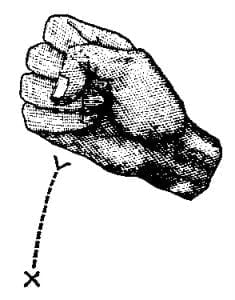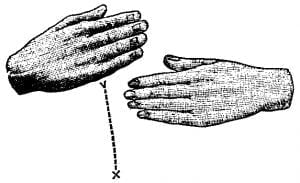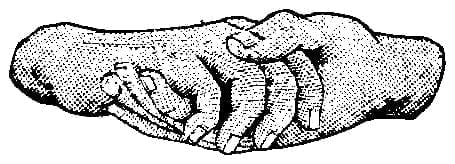The following is the farewell address of Kin Che-ess (Spectacles), medicine-man of the Wichitas, to Rev. A.J. Holt, missionary, on his departure from the Wichita Agency, in the words of the latter:

He placed one hand on my breast, the other on his own, then clasped his two hands together after the manner of our congratulationsWe are friends, Fig. 320. He placed one hand on me, the other on himself, then placed the first two fingers of his right hand between his lipsWe are brothers. He placed his right hand over my heart, his left hand over his own heart, then linked the first fingers of his right and left hands Our hearts are linked together. See Fig. 232, p. 386. He laid his right hand on me lightly, then put it to his mouth, with the knuckles lightly against his lips, and made the motion of flipping water from the right-hand forefinger, each flip casting the hand and arm from the mouth a foot or so, then bringing it back in the same position. (This repeated three or more times, signifying talk or talking.) Fig. 321.

He then made a motion with his right hand as if he were fanning his right ear; this repeated. He then extended his right hand with his index finger pointing upward, his eyes also being turned upwardYou told me of the Great Father. Pointing to himself, he hugged both hands to his bosom, as if he were affectionately clasping something he loved, and then pointed upward in the way before describedI love him (the Great Father). Laying his right hand on me, he clasped his hands to his bosom as beforeI love you. Placing his right hand on my shoulder, he threw it over his own right shoulder as if he were casting behind him a little chip, only when his hand was over his shoulder his index finger was pointing behind himYou go away. Pointing to his breast, he clinched the same hand as if it held a stick, and made a motion as if he were trying to strike something on the ground with the bottom of the stick held in an upright positionI stay, or I stay right here, Fig. 322.

Placing his right hand on me, he placed both his hands on his breast and breathed deeply two or three times, then using the index finger and thumb of each hand as if he were holding a small pin, he placed the two hands in this position as if he were holding a thread in each hand and between the thumb and forefinger of each hand close together, and then let his hands recede from each other, still holding his fingers in the same position, as if he were letting a thread slip between them until his hands were two feet apartYou live long time, Fig. 323.

Laying his right hand on his breast, then extending his forefinger of the same hand, holding it from him at half-arm’s length, the finger pointing nearly upward, then moving his hand, with the finger thus extended, from side to side about as rapidly as a man steps in walking, each time letting his hand get farther from him for three or four times, then suddenly placing his left hand in a horizontal position with the fingers extended and together so that the palm was sidewise, he used the right-hand palm, extended, fingers together, as a hatchet, and brought it down smartly, just missing the ends of the fingers of the left hand, Fig. 324.

Then placing his left hand, with the thumb and forefinger closed, to his heart, he brought his right hand, fingers in the same position, to his left; then, as if he were holding something between his thumb and forefinger, he moved his right hand away as if he were slowly casting a hair from him, his left hand remaining at his breast, and his eyes following his rightI go about a little while longer, but will be cut off shortly and my spirit will go away (or will die). Placing the thumbs and forefingers again in such a position as if he held a small thread between the thumb and forefinger of each hand, and the hands touching each other, he drew his hands slowly from each other, as if he were stretching a piece of gum-elastic; then laying his right hand on me, he extended the left hand in a horizontal position, fingers extended and closed, and brought down his right hand with fingers extended and together, so as to just miss the tips of the fingers of his left hand; then placing his left forefinger and thumb against his heart, he acted as if he took a hair from the forefinger and thumb of his left hand with the forefinger and thumb of the right, and slowly cast it from him, only letting his left hand remain at his breast, and let the index finger of the right hand point outward toward the distant horizonAfter a long time you die. When placing his left hand upon himself and his right hand upon me, he extended them upward over his head and clasped them thereWe then meet in heaven. Pointing upward, then to himself, then to me, he closed the third and little finger of his right hand, laying his thumb over them, then extending his first and second fingers about as far apart as the eyes, he brought his hand to his eyes, fingers pointing outward, and shot his hand outwardI see you up there. Pointing to me, then giving the last above-described sign of look, then pointing to himself, he made the sign as if stretching out a piece of gum-elastic between the fingers of his left and right hands, and then made the sign of cut-off before described, and then extended the palm of the right hand horizontally a foot from his waist, inside downward, then suddenly threw it half over and from him, as if you were to toss a chip from the back of the hand (this is the negative sign everywhere used among these Indians)I would see him a long time, which should never be cut off, i.e., always.Pointing upward, then rubbing the back of his left hand lightly with the forefinger of his right, he again gave the negative sign.No Indian there (in heaven). Pointing upward, then rubbing his forefinger over the back of my hand, he again made the negative signNo white man there. He made the same sign again, only he felt his hair with the forefinger and thumb of his right hand, rolling the hair several times between the fingersNo black man in heaven. Then rubbing the back of his hand and making the negative sign, rubbing the back of my hand and making the negative sign, feeling of one of his hairs with the thumb and forefinger of his right hand, and making the negative sign, then using both hands as if he were reaching around a hogshead, he brought the forefinger of his right hand to the front in an upright position after their manner of counting, and said therebyNo Indian, no white man, no black man, all one. Making the “hogshead” sign, and that for look, he placed the forefinger of each hand side by side pointing upwardAll look the same, or alike. Running his hands over his wild Indian costume and over my clothes, he made the “hogshead” sign, and that for same, and said therebyAll dress alike there. Then making the “hogshead” sign, and that for love, (hugging his hands), he extended both hands outward, palms turned downward, and made a sign exactly similar to the way ladies smooth a bed in making it; this is the sign for happyAll will be happy alike there. He then made the sign for talk and for Father, pointing to himself and to meYou pray for me. He then made the sign for go away, pointing to me, he threw right hand over his right shoulder so his index finger pointed behind himYou go away. Calling his name he made the sign for look and the sign of negation after pointing to me Kin Che-ess see you no more.
Fig. 322, an illustration in the preceding address, also represents a common gesture for sit down, if made to the right of the hip, toward the locality to be occupied by the individual invited. The latter closely corresponds to an Australian gesture described by Smyth (The Aborigines of Victoria, London, 1878,Vol. II, p. 308, Fig. 260), as follows: “Minnie-minnie (wait a little). It is shaken downwards rapidly two or three times. Done more slowly towards the ground, it means ‘Sitdown.'” This is reproduced in Fig. 325.



